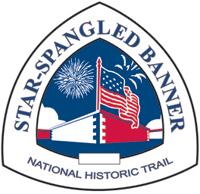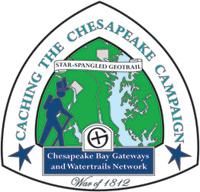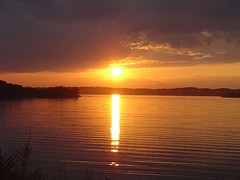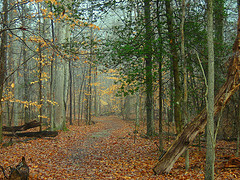During the first challenge along the Star-Spangled Banner GeoTrail, over 400 first edition SSB geocoins were awarded. We would like to thank everyone who participated in the Star-Spangled Banner GeoTour. We are currently out of geocoins but stay tuned for other opportunities along the Star-Spangled Banner GeoTour!


Come on a journey to remember and commemorate the dramatic chain of events, people and places that led to the birth of our National Anthem.
The story of the Star-Spangled Banner was shaped by the events of the Chesapeake Campaign during the War of 1812. From February 1813 until February 1815, the Chesapeake Bay was the center of a fierce struggle between the British and Americans. Places and landscapes still exist today that provide a touchstone to the past. The trail traces events and related sites that figured prominently in the Chesapeake Campaign of the War of 1812 that have national significance, physical integrity, and the potential for contemporary recreation and interpretation.
You are seeking a traditional hide located on the Wilson Spring Trail. Cachers should use the trail parking area. This park has a required fee. $3.00 on the weekdays $4.00 on weekends. Park hours are 8am to dusk.
The park offers hiking, biking, self-guided trails, fishing, boating, and a variety of educational programs. Ten bicycles are available for rent by the hour.

Mason Neck is a peninsula that juts prominently into the Potomac River. It is surrounded by Belmont Bay to the west, Gunston Cove to the east, and Pohick Bay to the northeast. Approximately two-thirds of the land is protected as a mix of regional, state and national preserves, including Mason Neck State Park. The peninsula’s hardwood forests and wetlands attract many migrating and non-migrating birds, including tundra swans, herons, bald eagles and assorted species of duck.
Mason Neck is the site of Gunston Hall, the 18thcentury plantation home of Virginia statesman and author of the Virginia Declaration of Rights, George Mason. In 1814, Gunston Hall was still home to Mason’s descendents, whose land holdings included most of the peninsula. However, it is worth noting that another interesting inhabitant of the Neck at that time was Martin Cockburn, uncle of the notorious British Admiral George Cockburn, whose raids of terror across Chesapeake Bay would make his name remembered and reviled in the region for decades to come!
In August 1814, the Potomac River was a busy place. A large British naval force, including frigates, bomb vessels and a rocket ship, under the command of Captain James Alexander Gordon, was sailing up the waterway in the direction of Washington, D.C. The ships likely passed in close proximity to Mason Neck, as they approached Fort Washington (then known as Fort Warburton). Located on the Maryland shore, about 8 miles below Washington, D.C., Fort Warburton represented the only major fortification on the River.
After capturing Fort Warburton with little resistance on August 27, the British had easy and direct access to Alexandria, just a few miles away. Negotiating from a position of overwhelming strength, Captain Gordon promised the city’s residents that his men would respect private property as long as no resistance was offered. At the mercy of the British, the town council acceded to the demands, and for the next five days Alexandria was looted of an estimated 16,000 barrels of flour, 1,000 hogsheads of tobacco, 150 bales of cotton and some $5,000 worth of wine, sugar and other items. For the most part, the British did not harass or destroy private property, and as a result the city avoided destruction and its residents were unharmed. This tactic did generate some criticism among other jurisdictions that actively fought against the invaders.

Following the looting of Alexandria, Gordon and his men left Northern Virginia, sailing back towards the mouth of the river and a planned rendezvous with the rest of the fleet. Newly appointed Secretary of War James Monroe hoped to trap the departing British and sent a group of cutters and fireboats after them, with little to no success. He next tried to catch them at the “White House” Battery on the grounds of present day Fort Belvoir. At this site, the Americans, under Commodore David Porter, had emplaced a total of 11 guns - five naval long guns and eight artillery field pieces, all situated on bluffs overlooking the Potomac across Gunston Cove from present day Mason Neck State Park.
This land had been part of a larger grant to Thomas, Sixth Lord Fairfax and proprietor of the massive Northern Neck land grant. William Fairfax, Thomas’s cousin and land agent, built Belvoir Manor in 1741. In 1783, the manor burned and by the summer of 1814, Ferdinando Fairfax owned the land and had constructed a simpler white house on the property giving the battery its name. As described by Christopher George in his work, Terror on the Chesapeake: The War of 1812 on the Bay, one of the notable sites that could have been seen from Mason Neck that September was a large, white banner hung by Porter that proclaimed “Free Trade and Sailors Rights.”
As the British passed the battery, the Americans opened fire, trading volleys with two enemy bombships. By mid-day on September 5th, the whole British squadron was brought up, totaling more than 63 guns, and the American troops were forced to withdraw. Further downriver, at Indian Head, Maryland, Captain Oliver Hazard Perry would also try to engage the enemy, but had only one gun powerful enough to reach the British fleet. This proved insufficient, and the British were able to make their escape down the river towards Chesapeake Bay and the upcoming Battle of Baltimore.
Visitors to Mason Neck State Park today can enjoy four miles of unpaved hiking trails and three miles of paved multi-use trails. Elevated walkways allow visitors to explore some of the marsh areas in the park as well. Popular activities include bicycling, bird watching, canoe trips and night hikes. The park also offers a Junior Ranger program, teacher workshops, hands-on experiential educational opportunities and “Your Backyard Classrooms” programs. The Elizabeth Hartwell Environmental Education Center has rotating interpretive displays and exhibits on local wildlife and the area’s history. This center provides an opportunity for teachers to conduct environmental studies in natural settings.

Thanks to Tim Smith, Chief Ranger for helping with this hide and to the Maryland Geocaching Society for assisting with this project!